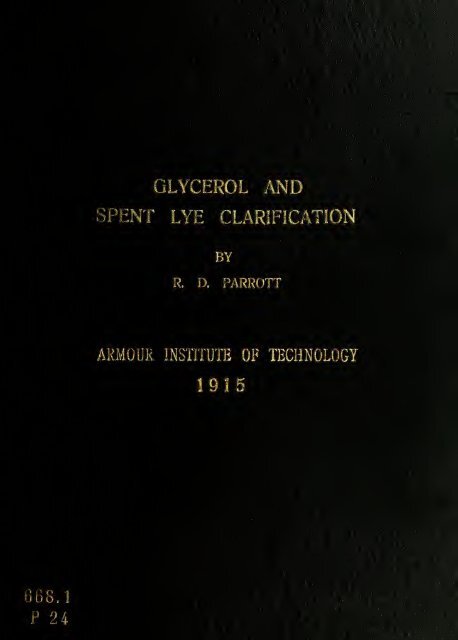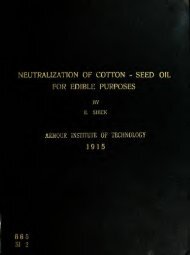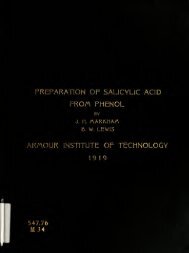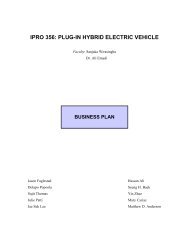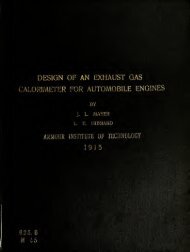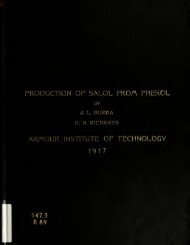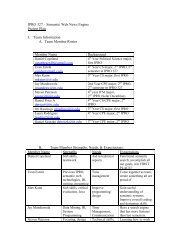Glycerol and spent lye clarification - Illinois Institute of Technology
Glycerol and spent lye clarification - Illinois Institute of Technology
Glycerol and spent lye clarification - Illinois Institute of Technology
Create successful ePaper yourself
Turn your PDF publications into a flip-book with our unique Google optimized e-Paper software.
lilincis <strong>Institute</strong><br />
<strong>of</strong> <strong>Technology</strong><br />
UNWERSJTY LIBRARIES
AT 382
GLYCEROL <strong>and</strong> SPENT LYE OLARIFIOATION<br />
A THESIS<br />
Presanted by<br />
RAYMOND. D. PARROTT<br />
To the<br />
PRESIDENT <strong>and</strong> FACULTY<br />
<strong>of</strong><br />
ARMOUR INSTITUTE <strong>of</strong> TECHNOLOGY<br />
for the degree <strong>of</strong><br />
BACHELOR <strong>of</strong> SCIENCE in CHEMICAL ENGINEERING<br />
Having completed the prescribed course <strong>of</strong> study in<br />
CHEMICAL ENGINEERING<br />
1915<br />
Dean <strong>of</strong> Eng. Studies. Pr<strong>of</strong>, <strong>of</strong> Chem. Engineering.<br />
Dean <strong>of</strong> Cultural Studies.<br />
^t<br />
ILLINOIS INSTITUTE OF TECHNOLOGY<br />
PAUL V. GALVIN LIBRARY<br />
35 WEST 33RD STREET<br />
CHICAGO, IL 60616
Preface.<br />
In selecting a thesis I have tried to<br />
keep in mind the uppermost object <strong>of</strong> a techni-<br />
cal training, a training that should enhance,<br />
not ones routine powers, but ones powers <strong>of</strong><br />
worldly insight <strong>and</strong> commercial attack.<br />
A technical graduate should be likened<br />
to a casting <strong>of</strong> untold dimensions, ready for<br />
the process <strong>of</strong> polishing, rather than an<br />
atomical dot already finished over by the<br />
routine grind.<br />
With the time that I have at my disposal<br />
I deem it advisable to select some small<br />
problem connected with the industrial labor-<br />
atory or the like.<br />
Hence with the sentiments as set forth<br />
above I have selected a phase <strong>of</strong> soap <strong>lye</strong><br />
<strong>clarification</strong>, a rapid analysis <strong>of</strong> glycerol<br />
by carbon dioxide evolution <strong>and</strong> a brief<br />
compilation <strong>of</strong> data <strong>and</strong> literature.<br />
II<br />
1 -:<br />
R. D. P., 1915.
Contents.<br />
Part I.<br />
Introduction. ---^------^ -Page 1.<br />
Part II.<br />
Lye Clarification. -.«-.------ Page 4,<br />
Evolution <strong>of</strong> the process j Kind <strong>of</strong> <strong>lye</strong>s;<br />
Yield <strong>of</strong> glycerine; Alkalinity <strong>of</strong> <strong>lye</strong>s; Acids<br />
for neutralizing alkali in <strong>lye</strong>; Metallic salts.<br />
Procel|dure for <strong>clarification</strong>; Neutral-<br />
ization <strong>of</strong> alkali; Theatment with metallic<br />
salts; Filtration,<br />
Nitrogenous matters; Cotton-seed oil<br />
soap <strong>lye</strong>8; Fermented <strong>lye</strong>s.<br />
Part III.<br />
Detection <strong>and</strong> Estimation <strong>of</strong> <strong>Glycerol</strong> - Page 14,<br />
Detection by physical properties;<br />
Quantitative test; Clarification <strong>of</strong> crude<br />
glycerol; Theory <strong>of</strong> estimation <strong>of</strong> glycerol<br />
"by carbon-dioxide ; Method <strong>of</strong> proceedure;<br />
Discussion <strong>of</strong> method; Apparatus for evolution<br />
<strong>of</strong> carbon-dioxide.<br />
Ill
Part IV.<br />
Properties -----.-------.- -Page 28.<br />
Physical Properties.<br />
Chemical Properties. Esters, organic;<br />
Esters, inorganic; Alkali compounds; Glycer-<br />
inates; Glyceroxidee; Reduction <strong>of</strong> metallic<br />
oxides.<br />
Part y.<br />
Appendix ----^-.-.--..---« -Page 39.<br />
References.<br />
Miscellaneous Tables.<br />
Boiling points at reduced pressures.<br />
Specific gravity <strong>of</strong> aqueous solutions<br />
<strong>of</strong> glycerol.<br />
Refractive index <strong>of</strong> aqueous solutions.<br />
IV
Introduction.<br />
In the general advance <strong>of</strong> technical<br />
knowledge <strong>and</strong> research during the last century<br />
the soap industry has not remained stationary.<br />
About 1823 Ohevreul published his researches<br />
on the constitution <strong>of</strong> fats, showing that<br />
instead <strong>of</strong> consisting <strong>of</strong> a single substance<br />
they were composed <strong>of</strong> fatty acids in combin-<br />
ation with a base, glycerol, <strong>and</strong> that glycerol<br />
was contained in the waste liquors <strong>of</strong> the soap<br />
<strong>and</strong> c<strong>and</strong>le factories.<br />
When the remarkable properties <strong>of</strong> glycer-<br />
ol, such as its permanence <strong>and</strong> non-volatility<br />
at ordinary temperatures. Its s<strong>of</strong>tening effects<br />
on the skin <strong>and</strong> the value in cosmetic prepar-<br />
ations, its oily nature combined with its mis-<br />
cibility with water <strong>and</strong> alcohol, its enormous<br />
solvent powers, its sweet etnd agreeable taste<br />
<strong>and</strong> finally its value as a base for the most<br />
valuble <strong>of</strong> all explosives, nitroglycerine euid<br />
dynamite, which are not known in any other one<br />
substance, became known manufacturers began to
figure how this soap <strong>lye</strong>, which had been run<br />
<strong>of</strong>f into the gutters, might he worked for its<br />
valuable glyoerine content.<br />
Soap <strong>lye</strong> as run from the kettle, consists<br />
<strong>of</strong> water, holding in solution the salt added<br />
to separate the soap, in the fonn <strong>of</strong> sodium<br />
hydrate euid carbonate, albuminous matter <strong>and</strong><br />
free alkali, both in solution <strong>and</strong> suspension,<br />
in certain cases gums, <strong>and</strong> the glycerol.<br />
The problem that confronted <strong>and</strong> still<br />
confronts the soap <strong>and</strong> glyoerine manufacturer<br />
is how to get this valuable glycerol out <strong>of</strong><br />
that conglomeration <strong>and</strong> into a pure state in<br />
the easiest euid cheapest meuiner.<br />
<strong>Glycerol</strong>, as it is produced, amounts to<br />
85,000 tons annually. The glycerine industry<br />
is exclusively a by-product industry <strong>of</strong> the<br />
soap <strong>and</strong> c<strong>and</strong>le trade <strong>and</strong> the output depends<br />
not so much on the dem<strong>and</strong> for glycerine as on<br />
the worlds requirements <strong>of</strong> soap <strong>and</strong> c<strong>and</strong>les.<br />
This condition is brought about by the<br />
fact that fats only contain from 10.5 f>
glycerol in tallow to 13.5 f in cocoanut oil.<br />
In practice this percentage <strong>of</strong> glycerol is out<br />
down by the free fatty acids in the fat, each<br />
10 f <strong>of</strong> free fatty acids in the fats reducing<br />
the percentage <strong>of</strong> glycerol by about 10 ^.<br />
(Rogers.<br />
<strong>Glycerol</strong> has been subject to wide fluc-<br />
tuations in price; the "dynamite** grade<br />
selling at 10 cents per pound in 1908, 26<br />
cents per pound in 1911, <strong>and</strong> 18 cents per<br />
pound in 1915. The United States does not<br />
produce enough glycerol for its own use hence<br />
from 30 to 40 million pounds <strong>of</strong> foreign crude<br />
are imported annually.
Lye Clarification.<br />
<strong>Glycerol</strong> is so closely associated with<br />
the soap industry that no soap plant is com-<br />
plete without its department for saving the<br />
glycerol contained in the fats <strong>and</strong> oils used<br />
by the soap maker.<br />
For msmy years chemists <strong>and</strong> engineers<br />
have been directing their energies toward<br />
improving processes <strong>and</strong> machinery for the<br />
recovery <strong>of</strong> glycerol from <strong>spent</strong> soap <strong>lye</strong>.<br />
Many patents have been granted <strong>and</strong> many pro-<br />
cesses developed each having a common object<br />
<strong>of</strong> glycerol recovery. There can be traced a<br />
gradual evolution in effeciency <strong>of</strong> proceedure<br />
<strong>and</strong> apparatus designed to remove the organic<br />
matter from the <strong>lye</strong>, to concentrate this clar-<br />
ified <strong>lye</strong>, thereby removing the greater part<br />
<strong>of</strong> the dissolved salts, €tnd to continue the<br />
concentration till crude glycerine is obtain-<br />
ed, which further remains to be purified by<br />
distillation.
Metallic salts, such as sulphate <strong>of</strong> Iron<br />
<strong>and</strong> altiminum, were used in the early stages <strong>of</strong><br />
<strong>lye</strong> treatment for coagrolatlng <strong>and</strong> purifying<br />
agents, as in the process <strong>of</strong> L, M, Brochon, in<br />
1882 <strong>and</strong> J. P. Battershall in 1883 <strong>and</strong> later<br />
by Van Ruyrabeke in 1891. The Van Ruymbeke<br />
process for recovering the glycerol from still<br />
fats was an important step in 1894. In 1904<br />
Garrigue developed his process for eliminating<br />
volatile fatty acids previous to distillation.<br />
Domeir <strong>and</strong> Hagomann, in 1890 first used<br />
the closed aalt separator which was later<br />
applied to vacuum evaporators by Foster in<br />
1899. 0. Laist, in 1893 applied the air<br />
condenser to glycerol stills, but the first<br />
use <strong>of</strong> vacuum had been in 1882 in connection<br />
with the apparatus <strong>of</strong> Arm<strong>and</strong>y. In 1891 Van<br />
Ruymbeke combined the use <strong>of</strong> the high vacuTim<br />
with heating still by means <strong>of</strong> saturated<br />
steam; in 1894 applied the injection <strong>of</strong> exp<strong>and</strong>-<br />
ed <strong>and</strong> reheated steam to glycerine stills.
In 1904 Garrlgue utilized the heat <strong>of</strong> the<br />
glycerine vapor for superheating low pressure<br />
steam injected into the still. ( For a com-<br />
plete account <strong>of</strong> the distillation <strong>and</strong> refining<br />
<strong>of</strong> crude glycerine the reader is refered to the<br />
literature.<br />
Spent soap <strong>lye</strong>s as produced by the modem<br />
soap factory vary in quality depending upon<br />
the practice <strong>of</strong> the soap maker. The refiner<br />
would <strong>of</strong> course prefer to receive <strong>lye</strong>s free<br />
from impurities <strong>and</strong> coloring matter, but the<br />
object <strong>of</strong> passing water through the kettle<br />
is to remove the dirt <strong>and</strong> coloring matter<br />
from the soap as well as to obtain a good<br />
yield <strong>of</strong> glycerol. It is advisable, however,<br />
to avoid running nigre <strong>and</strong> rosin <strong>lye</strong> to the<br />
glycerine plant, <strong>and</strong> this can only be done<br />
when the glycerine has been properly removed<br />
from the soap before the nigre <strong>and</strong> rosin are<br />
added.<br />
The yield <strong>of</strong> glycerine obtainable from<br />
soap stock is entirely dependent on the amount<br />
"6
<strong>of</strong> the <strong>lye</strong> removed from the kettle. The best<br />
practice is to get about 90 *fo <strong>of</strong> the glycerine<br />
in the stock into the crude. To obtain this<br />
yield necessitates the removal <strong>of</strong> at least<br />
three pounds <strong>of</strong> <strong>lye</strong> per pound <strong>of</strong> stock sapon-<br />
ified, not counting any rosin that may have<br />
been used.<br />
If rosin <strong>and</strong> nigre <strong>lye</strong>s are used there<br />
will be much coloring matter from the rosin<br />
<strong>and</strong> nigre. All <strong>lye</strong>s will separate some soap<br />
on cooling <strong>and</strong> a storage tank should be provid-<br />
ed for the <strong>lye</strong> waiting to be heated <strong>and</strong> from<br />
which the separated soap can be skimmed.<br />
No <strong>lye</strong>s should be drawn from the glycerine<br />
tanks in the plant contsning sufficient<br />
strength to raise the average <strong>of</strong> all the <strong>lye</strong>s<br />
to more than 0.4 ^ total alkalinity. This<br />
low figure will result in a large saving both<br />
in caustic soda in the soap factory <strong>and</strong> acid<br />
used to neutralize the alkalinity <strong>of</strong> the <strong>lye</strong><br />
in the glycerine plant.<br />
After the soap has cooled <strong>and</strong> all the
sepaj?ated soap has been sTcimmed <strong>of</strong>f it is<br />
removed to the glycerine plant where it is to<br />
be treated before going to the evaporators.<br />
The alkali in the <strong>lye</strong> must be neutralized <strong>and</strong><br />
the organic impurities removed.<br />
The neutralization <strong>of</strong> the alkali is<br />
affected by the addition <strong>of</strong> hydrochloric or<br />
sulphuric acids. The use <strong>of</strong> the former is<br />
open to objection due to high cost. It has<br />
the advantage, however, <strong>of</strong> producing as a<br />
result <strong>of</strong> the chemical action, sodium chloride<br />
which after recovery can be used again in the<br />
soap kettle.<br />
Sulphuric acid is most generally used.<br />
Its use introduces sulphate into the <strong>lye</strong> which<br />
salt is recovered with the common salt from<br />
the evaporator. Sodium sulphate however is<br />
practically useless for graining soap, its<br />
graining qualities being but three fifths that<br />
<strong>of</strong> sodium chloride <strong>and</strong> the grain produced is<br />
s<strong>of</strong>t <strong>and</strong> <strong>of</strong>ten hard to separate from the <strong>lye</strong>.<br />
To remove the organic impurities some<br />
9
means must be employed to render them insol-<br />
uble. This is best accomplished by the<br />
addition <strong>of</strong> metallic salts, forming insoluble<br />
metallic oompo-unds, which are coagulated when<br />
the <strong>lye</strong> is neutralized.<br />
The chief aim in using a metallic salt<br />
in the purification <strong>of</strong> soap <strong>lye</strong>s is the removal<br />
<strong>of</strong> the soaps <strong>of</strong> the lower fatty acids, formic,<br />
acetic, butyric, caprylic, etc,.<br />
The amount <strong>of</strong> aluminum sulphate to be<br />
used depends on the cleanliness <strong>of</strong> the <strong>lye</strong><br />
<strong>and</strong> its freedom from soap <strong>and</strong> gelatinous<br />
matters. The least amount that will give a<br />
good cake in the filter press <strong>and</strong> not gum the<br />
cloths is the amount to use. This salt can<br />
bo added either dry or dissolved in water <strong>and</strong><br />
will neutralize about one third its weight <strong>of</strong><br />
caustic soda. An exoess <strong>of</strong> caustic soda in<br />
the <strong>lye</strong> has the tendency to form aluminum<br />
hydrate which will retard filtering.<br />
There are anumber <strong>of</strong> compounds on the<br />
market for which special advantages in <strong>lye</strong>
treatment are claimed. For this work, however,<br />
the lower grades <strong>of</strong> aluminiom sulphate are amply<br />
effecient <strong>and</strong> cheap enough to <strong>of</strong>fset any advan-<br />
tage <strong>of</strong> the special chemicals.<br />
Some operators prefer to determine the<br />
amount <strong>of</strong> alkali in the <strong>lye</strong> by chemical anal-<br />
ysis cmd then estimate the weight <strong>of</strong> acid to<br />
be added to bring the <strong>lye</strong> to neutral, making<br />
proper deduction for the amount <strong>of</strong> alkali<br />
neutralized by the aluminiim sulphate. This,<br />
however, is unnecessary, as by means <strong>of</strong> a good<br />
neutral litmus paper ( alkaline or acid will<br />
do ) a careful man can bring the <strong>lye</strong> to between<br />
neutral <strong>and</strong> 0,01 J^ alkaline.<br />
All <strong>lye</strong>s will contain some carbonate <strong>of</strong><br />
soda. Carbonates in the <strong>lye</strong> have the ten-<br />
dency to cause foaming in the evaporator <strong>and</strong><br />
also give misleading results with litmus.<br />
With the above in view the best proceedure is<br />
as follows:-<br />
The <strong>lye</strong> is placed in a tank which is fit-<br />
ted with a stirring or agitating apparatus.<br />
10
With the agitator (air) in action a portion <strong>of</strong><br />
the acid is added - enough to just talre up the<br />
free caustic - then add the aluminum sulphate.<br />
After the chemical is well mixed in the <strong>lye</strong><br />
should be alkaline. Now enough acid should<br />
be added to just carry the <strong>lye</strong> to the neutral<br />
point or perhaps to the point <strong>of</strong> acidity as<br />
indicated by the faint pink <strong>of</strong> the litmus<br />
paper. Care should be exercised to thorough-<br />
ly agitate the <strong>lye</strong> during all stages <strong>of</strong> the<br />
treatment, stirring making the liquor uniform-<br />
ly acid or alkaline as the case may be.<br />
Agitating or stirring seems to facilitate a<br />
more readily "setable" precipitate.<br />
All <strong>lye</strong>s will contain nitrogenous matter,<br />
the amount varying with the care used in<br />
rendering, Tfhen <strong>lye</strong>s are thus treated this<br />
is not removed, most <strong>of</strong> it appearing in the<br />
crude, increasing the figure for non-volatile<br />
orgajilc residue. If the <strong>lye</strong> is made alkaline<br />
before evaporation this nitrogenous matter<br />
partly decomposes <strong>and</strong> gives <strong>of</strong>f ammonia gas.<br />
11
In the atill its decomposition continues<br />
( the crude always being distilled alkaline )<br />
the ammonia gas passing out through the vacu-<br />
um pump. With alkaline distillation there is<br />
no accumixLation <strong>of</strong> nitrogen in the still foots<br />
when these are returned to the <strong>lye</strong>s, showing<br />
ultimate decomposition <strong>of</strong> all nitrogenous<br />
matter.<br />
Crude <strong>lye</strong> from cottonseed soap stock<br />
contains nitrogenous acid bodies that resist<br />
this decomposition thus necessitating waste<br />
<strong>of</strong> all still residues. The same applys to<br />
crudes obtained by the autoclave or twitohell<br />
process from cottonseed soap stock <strong>and</strong> black<br />
grease.<br />
Lyes stored free from caustic ferment,<br />
the nitrogenous matter decomposing, producing<br />
sulphides which give <strong>of</strong>f hydrogen sulphide on<br />
acidifying <strong>and</strong> some glycerol is converted to<br />
trime thylene glycol.<br />
Fermented <strong>lye</strong>s give considerable trouble<br />
irt the evaporator by foaming. The sulphides<br />
le
also give trouble by corroding the apparatus,<br />
It is sometimes impossible to evaporate the<br />
fermented <strong>lye</strong>s because <strong>of</strong> the excessive<br />
foaming.<br />
13
<strong>Glycerol</strong> Detection <strong>and</strong> Estimation.<br />
When in a state <strong>of</strong> reasonable purity end<br />
concentration glycerol may be recognized by its<br />
physical properties. No other substance<br />
likely to be met with exhibits the combined<br />
characteristics <strong>of</strong> a dense viscous liquid <strong>of</strong><br />
sweet taste <strong>and</strong> neutral reaction? a mis-<br />
cibility with water <strong>and</strong> alcohol in all pro-<br />
portions; volatile at a high temperature; <strong>and</strong><br />
a burning with a blue flame when kindled,<br />
leaving no carbonaceous residue.<br />
The most characteristic property <strong>of</strong><br />
glycerol is its behavior when heated in a<br />
concentrated state with potassium hydrogen<br />
sulphate, whereby it is converted into<br />
acrolein ( C H ) with the elimination <strong>of</strong><br />
3 4<br />
water (CHO„/Z\° — CHO / 2H0)<br />
383^ 34 2<br />
The acrolein is recognizable by its extremely<br />
penetrating odor, resembling that <strong>of</strong> burning<br />
fat, <strong>and</strong> its property <strong>of</strong> causing the eyes to<br />
water. If the vapors be passed into water,<br />
the warm solution will be foiind to have the<br />
14
properties <strong>of</strong> an aldehyde, e.g., <strong>of</strong> reducing<br />
armnonlacal silver nitrate, with the fonnation<br />
<strong>of</strong> a mirror <strong>of</strong> metallic silver.<br />
The following test is recommended by<br />
Griinhut (Zeit. Anal. Ohem. , 1899, 37, 38,) as<br />
the best qualitative test for glycerol :-<br />
The substance supposed to contain glycerol is<br />
mixed with twice its weight <strong>of</strong> potassium<br />
hydrogen sulphate <strong>and</strong> strongly heated until it<br />
foams; the vapors are lead into a test-tube<br />
cooled with a freezing mixture. The distil-<br />
late smells strongly <strong>of</strong> acrolein if glycerol<br />
Is present. To confirm, add a few drops <strong>of</strong> a<br />
mixture <strong>of</strong> solutions <strong>of</strong> three grams silver<br />
nitrate in thirty grams <strong>of</strong> ammonia sp. gr«<br />
.923 <strong>and</strong> three grams <strong>of</strong> sodium hydroxide in<br />
thirty grams <strong>of</strong> water. The silver mirror<br />
should form in the cold.<br />
The accurate estimation <strong>of</strong> glycerol in a<br />
complex mixture with other neutral organic<br />
substances <strong>and</strong> with inorganic material, has not<br />
received a satisfactory solution under all<br />
is
circumstances. The problem ia complicated "by<br />
the fact that solutions <strong>of</strong> glycerol can not be<br />
highly concentrated (see elsewhere) without<br />
serious loss from volatilization, <strong>and</strong> that the<br />
presence <strong>of</strong> glycerol naturally increases the<br />
solubility <strong>of</strong> many substances in aqueous <strong>and</strong><br />
alcoholic solutions.<br />
In general the first step in the estima-<br />
tion <strong>of</strong> glycerol consists in separating it<br />
from other substances with which it is mixed<br />
or combined so as to obtain it in a state <strong>of</strong><br />
approximate purity. This can <strong>of</strong>ten be effect-<br />
ed qualitatively in a very satisfactory<br />
manner, but it too <strong>of</strong>ten happens that the<br />
evaporations which are necessary steps in the<br />
process cause such a loss <strong>of</strong> glycerol by<br />
volatilization as to render the result <strong>of</strong><br />
little value for quantitative purposes.<br />
Proteins <strong>and</strong> some other foreign substances<br />
may be separated from a solution containing<br />
glycerol by adding a solution <strong>of</strong> basic lead<br />
acetate <strong>and</strong> then filtering them out <strong>of</strong> the<br />
16
solution. Chloridea may be removed by the<br />
addition <strong>of</strong> some soluble silver salt such as<br />
the nitrate, or the oxide, silver chloride<br />
being precipitated <strong>and</strong> filtered from the<br />
solution.<br />
Proteins <strong>and</strong> some other organic substances<br />
can <strong>of</strong>ten be removed completely by precipitat-<br />
ing the slightly alkaline solution with zinc<br />
chloride. The precipitate is filtered <strong>of</strong>f<br />
<strong>and</strong> the filtrate rendered slightly acid when<br />
further precipitation will <strong>of</strong>ten occur.<br />
The last traces <strong>of</strong> zinc may be removed from<br />
the solution by adding potassium ferrocyanide,<br />
which is also a very good precipitant <strong>of</strong><br />
albumen.<br />
At the present writing there seems to be<br />
no accurate method for the determination <strong>of</strong><br />
glycerol <strong>of</strong> all percentages in complex<br />
mixtures. In aqueous solutions glycerol can<br />
be determined accurately by means <strong>of</strong> specific<br />
gravity <strong>and</strong> refractive index, Lenz recommends<br />
that the refractive index <strong>of</strong> glycerol solution<br />
17
<strong>and</strong> pure water be observed suocesaively.<br />
Tablea in the appendix give the differences<br />
between the refractive index <strong>of</strong> water <strong>and</strong><br />
aqueous solutions <strong>of</strong> glycerol <strong>of</strong> different<br />
concentration. The table <strong>of</strong> specific gravity<br />
<strong>of</strong> aqueous solutions is also given in the<br />
appendix.<br />
F. Schulze (Chem. Zeit., 1906, 29, 976,)<br />
has recently made a systematic comparison <strong>of</strong><br />
the methods in us© for estimating glycerol; he<br />
gives tables showing the results obtained with<br />
fats, soaps, <strong>and</strong> various commercial glycerols.<br />
The following are his principle conclusions :-<br />
(1) The permanganate method is considered<br />
unreliable in all cases, whether carried out<br />
by the method <strong>of</strong> Benedikt <strong>and</strong> Zisigmondy or by<br />
Herbig or Mangold's modifications.<br />
(2) The diohroraate method gives high results.<br />
Approximate values may be obtained by lowering<br />
the figures obtained by ten percent. This<br />
method is valid only in the absence <strong>of</strong> phos-<br />
phoric acid.<br />
18
(3) Zeisel <strong>and</strong> Fsmto's method is regarded as<br />
the most accurate for scientific <strong>and</strong> general<br />
purposes, but is too expensive for ordinary<br />
factory working,<br />
(4) The ace tin method failed to give con-<br />
cordant results. If this method is still to<br />
be employed, it is essential that the mean <strong>of</strong><br />
several estimations be taken,<br />
Lewkowitsch (Chemical <strong>Technology</strong> <strong>of</strong> Fats<br />
<strong>and</strong> Oils) considers that for ascertaining the<br />
proportion <strong>of</strong> glycerol in its pure dilute<br />
aqueous solution, oxidation methods are best,<br />
<strong>and</strong> that either permanganate or dichromate<br />
method gives good results in such cases. On<br />
the other h<strong>and</strong>, there is no doubt that such<br />
methods give high results with impure glycerol.<br />
In such cases the acetin method is prefered.<br />
Panto's method is said by Lewkowitsch not to<br />
be good.<br />
An attempt has been made to estimate the<br />
glycerol content <strong>of</strong> a solution or mixture by<br />
carbon-dioxide absorption. The method is<br />
19
aaed upon the oxidation reaction <strong>of</strong> glycerol<br />
by dichromate in sulphuric acid solution as<br />
represented by the following equation:-<br />
3 CgHgOg / 7 KgCrgO^ / 28 H^SO^ ->-<br />
7 HgSO^ / 7 CrgfSO^)^ / 9 00^ / 40 HgO.<br />
or<br />
2 C„H„0„ / 2 0„ —>- 6 C0„ / 8 H„0.<br />
3 8 3 2 2 2<br />
The carbon-dioxide is absorbed in potassium<br />
hydroxide (Geissler Bulb) <strong>and</strong> weighed; the<br />
carbon-dioxide is calculated to glycerol<br />
(or carbon-dioxide X .693 «>• glycerol) The<br />
results upon repetition agree well. The<br />
method is easy <strong>and</strong> rapid. With pure glycerol<br />
the oxidation is quantative. Crude glycerols<br />
must be treated to remove the impurities,<br />
Details:-<br />
About 6 grams <strong>of</strong> the sample is weighed<br />
(by difference) into a 250 c.c. volumetric<br />
flask, 50 c.c. <strong>of</strong> water added <strong>and</strong> the contents<br />
dissolved by shaking. A piece <strong>of</strong> blue<br />
litmus paper is dropped into the flask <strong>and</strong><br />
20
dilute sulphuric acid added until the litmus<br />
shows a faint pink. A 10 ^S solution <strong>of</strong> silver<br />
nitrate until all chlorine <strong>and</strong> aldehydic com-<br />
pounds are precipitated, Basic lead acetate<br />
is then added in slight excess to remove<br />
alhumen <strong>and</strong> nitrogenous matter. Excess lead<br />
is removed by precipitating with sulphuric<br />
acid. The solution is made up to 250 c.c.<br />
<strong>and</strong> a portion filtered through a dry paper,<br />
Twenty five c.c, <strong>of</strong> the filtrate is placed in<br />
the evolution flask <strong>and</strong> 4 grams <strong>of</strong> dichromate<br />
are added. The mixture is boiled gently for<br />
one hour. The carbon-dioxide is weighed <strong>and</strong><br />
calculated to glycerol. Carbon-dioxide times<br />
,693 gives the glycerol content. (<strong>Glycerol</strong><br />
content) divided by (Weight <strong>of</strong> sample divided<br />
by 10) gives Percent <strong>Glycerol</strong>,<br />
Any bubbles or froth that may be present<br />
while making up to the 250 c.c, mark may be<br />
dispelled by the addition <strong>of</strong> 2 or 3 drops <strong>of</strong><br />
concentrated sulphuric acid.<br />
21
From the proportion :-<br />
30H0 :7KCrO ::.5:X.<br />
3 8 3 2 2 7<br />
Half a gram <strong>of</strong> pure glycerol requires 3.73<br />
grams <strong>of</strong> potassium dichromate for complete<br />
oxidation. In operation however a slight<br />
excess is used. The dichromate solution as<br />
added to the ©volution flask is made up as<br />
follows :-<br />
4 grams <strong>of</strong> KgCrgO^.<br />
25 grams <strong>of</strong> HgO,<br />
15 grams <strong>of</strong> HgSO^,<br />
The merits <strong>of</strong> the method may be compared<br />
<strong>and</strong> suraed up as foil owe:<br />
In the titration method the dichromate<br />
solution is necessarily a somewhat stronger<br />
one, hence the measurements must be made with<br />
the greatest care, attention being paid to<br />
temperature.<br />
In the absorption method all errors are<br />
eliminated, no attention being paid to<br />
temperature.<br />
8g
The titration method is open to the<br />
objection that by precipitation by lead acetate<br />
the impurities may not be perfectly removed,<br />
anything left being oxidized <strong>and</strong> counted as<br />
glycerol.<br />
With the removal <strong>of</strong> all higher fatty acids<br />
<strong>and</strong> all resins <strong>and</strong> carbonates, as well as<br />
albuminoids, sulphides, thiocyanates, <strong>and</strong><br />
aldehydes, (which is accomplished by the<br />
addition <strong>of</strong> basic lead acetate) the error due<br />
to oxidation is eliminated with the elimina*-<br />
tion <strong>of</strong> all carbon. The lower fatty acids<br />
such as acetic, butyric, caprylic, <strong>and</strong> formic<br />
(should they escape the metallic salts in the<br />
<strong>lye</strong> <strong>clarification</strong>) are not attacked by chromic<br />
acid. The chlorides <strong>and</strong> aldehydic compounds<br />
are removed alike with soluble silver salts in<br />
either method.<br />
Check determinations with the absorption<br />
method agree very well with all percentages<br />
<strong>of</strong> glycerol, wherae with the other methods at<br />
h<strong>and</strong> results with low percentages are anything<br />
but concordant
The following table gives the results <strong>of</strong><br />
the estimation <strong>of</strong> glycerol by the absorption<br />
method on five samples <strong>and</strong> in two instances<br />
checks by the acetin method.<br />
Sample Weight Weight Percent Weight HCl Percent<br />
No. <strong>of</strong> <strong>of</strong> <strong>of</strong> <strong>of</strong> c.c. <strong>of</strong><br />
Sample CO , <strong>Glycerol</strong>. Sample Used. <strong>Glycerol</strong>,<br />
5.2512 .6255 82.55<br />
5.2612 .6248 82.47<br />
5.2818 .6286 82.49<br />
1481 5.5095 .5283 66.40<br />
1481 3.5437 .3378 66.10<br />
1481 3.5437 .3350 65.60<br />
1481 3.5437 .3400 66.55<br />
1481 3.5437 .3350 65.60<br />
1 4.5893 .2014 50.41<br />
1 4.5893 .1994 30.11<br />
1 4.5893 .2007 30.31<br />
2 4.2718 .1626 26.37<br />
2 4.2718 .1612 26.15<br />
2 4.2718 .1619 26.26<br />
3 6.1207 .0401 4.54<br />
3 6.1807 .0415 4.70<br />
24<br />
1.0152 52.0 82.60<br />
1.3076 66.9 82.35<br />
1.1895 60.9 82.50<br />
1.1076 46.0 66.35<br />
1.0970 44.9 66.00<br />
1.1172 45.3 65.40<br />
.9493 39.4 66.60
The ace tin method is the one agreed upon at a<br />
conference <strong>of</strong> delegates from American, British,<br />
French, <strong>and</strong> German committees <strong>and</strong> has been confirm-<br />
ed by each <strong>of</strong> the above conmiittees as giving<br />
results nearest the truth on crude glycerines In<br />
general<br />
The column in the above table headed "c.c.<br />
HCl used" refers to the acid equivalent <strong>of</strong> the<br />
sodivun hydroxide used for the saponification <strong>of</strong><br />
the acetin.<br />
As 20 CO. <strong>of</strong> strong NaOH 5 93.4 c.c. Std. HCl<br />
one c.c. <strong>of</strong> HCl is equivalent to .016125 grams <strong>of</strong><br />
glycerol.<br />
93,4 - 41,4 - S2 CO. HCl used for<br />
saponification. (The 41,4 c.c. HCl is that used<br />
to titrate the excess <strong>of</strong> NaOH.<br />
The apparatus is shown in the cut. The<br />
parts, bottles, U tubes, absorption bulb, eto,,<br />
are fastened to the st<strong>and</strong> (by means <strong>of</strong> wire) which<br />
consists <strong>of</strong> an upright st<strong>and</strong> <strong>and</strong> two oross rods.<br />
An aspirator ia attached by means <strong>of</strong> which the<br />
evolved carbon-dioxide is drawn to the Geissler<br />
25
ulb <strong>and</strong> absorbed.<br />
The sample is put into tlie flask (6), the<br />
Geiasler (12) having been filled with 40 ^<br />
potassium hydroxide solution <strong>and</strong> weighed is put in<br />
its place ajid the aspirator or ordinary suction<br />
pump is started. The dichromate solution is run<br />
into the flask (6) from the dropping funnel (5)<br />
<strong>and</strong> a small flame is then applied to the flask (6).<br />
A current <strong>of</strong> (atmospheric) air enters the system<br />
(suction) at the Geissler bulb (1) where any carbon-<br />
dioxide in the air is absorbed by the 40 ^ potassium<br />
hydroxide therein. From the Geissler bulb the<br />
current <strong>of</strong> air goes through the soda lime U tube<br />
<strong>and</strong> then into the bottles 3 <strong>and</strong> 4 containing<br />
sulphuric acid <strong>and</strong> enters the flask (6) through<br />
the dropping funnel (5). (Any water in the air<br />
is removed by the double safety device - soda lime<br />
<strong>and</strong> sulphuric acid.) From the flask (6) the<br />
current <strong>of</strong> air plus the evolved carbon-dioxide<br />
which is forming continuously ascends through the<br />
condenser (7) to the safety tube (8) which contains<br />
moistened glass beads. These beads are inserted<br />
in the circuit as a precautionary measure for<br />
26
catching any chlorine that may be present or water<br />
that has not condensed in the condenser (7).<br />
From the tube (8) the current passes through the<br />
sulphuric acid U tube (9) <strong>and</strong> then through the<br />
oalcitjin chloride U tube (10) where any moisture is<br />
collected. Prom the calcium chloride tube (8)<br />
the current passes through a second calcium<br />
chloride tube (11) <strong>and</strong> then to the Geissler (12)<br />
<strong>and</strong> small calcium chloride tube attached to the<br />
Geissler <strong>and</strong> through a calcitun chloride tube to<br />
the pump, the last drying tube being a safety<br />
device to keep moisture from entering the Geissler<br />
from the pump direction.<br />
The apparatus needs no further attention than<br />
to assure that a current <strong>of</strong> air is kept moving<br />
through the eyetein so as to eliminate any backing<br />
up <strong>of</strong> acid in bottles 3 <strong>and</strong> 4.<br />
27
Properties.<br />
<strong>Glycerol</strong>, or "chemically pure" glycei'ine ie<br />
a colorless, odorlesB, viecid liquid, having a<br />
sweet taste. It ia optically inactive <strong>and</strong> is<br />
neutral to indicators. On exposure to cold<br />
for a prolonged time it crystallizee in rhombic<br />
crystal B which melt at 20° centigrade. With<br />
the aid <strong>of</strong> a few crystals large quantities <strong>of</strong><br />
glycerol CB,n be easily converted into a crystal-<br />
line mass at 0*^ centigrade.<br />
<strong>Glycerol</strong> is oily to the touch <strong>and</strong> produces<br />
on the skin, especially the nnicuous membranes,<br />
the sensation <strong>of</strong> heat, due to its power <strong>of</strong><br />
absorbing moisture from the tissues. The<br />
water absorbing power <strong>of</strong> glycerol amounts to<br />
50 ^ <strong>of</strong> its o^Tn weight.<br />
At ordinary temperatures glycerol does not<br />
volatilize; at the boiling point <strong>of</strong> water, how-<br />
ever, appreciable quantities escape as vapor.<br />
<strong>Glycerol</strong> boils under 760 ip.m. at 290° C with a<br />
slight decomposition. At pressures under<br />
12 m.m. it distills ixnchenged. The specific<br />
28
gravity ^e given by the most reliable observers<br />
iss-<br />
15° 17.5°<br />
d -»-- c Z 1.26468, d—— J. C - 1.2620<br />
15° 17.5°<br />
The following table computed by Richardson<br />
<strong>and</strong> taken from Lewkowitsch. Vol. 1, Fifth Ed.<br />
contains the most reliable observations <strong>of</strong><br />
boiling points under reduced pressures.<br />
Pressure<br />
In Millimeters
Pressure<br />
In Millimeters
glycerol <strong>and</strong> water are mieclble in all pro-<br />
portions, the composition <strong>of</strong> the escaping<br />
vapors cannot be calculated according to<br />
Dalton's well known law, but lEust be derived<br />
from actual observations. Gerlach determined,<br />
with the aid <strong>of</strong> a vaporirceter, in which the<br />
pressure <strong>of</strong> the vapor was measured by a column<br />
<strong>of</strong> mercury, the vapor pressures as given in<br />
the appendix.<br />
Prom the table an approximate measure<br />
can be derived aa to the losses that may be<br />
inctirred on evaporating dilute solutions <strong>of</strong><br />
glycerol.<br />
Experiments showed that up to a con-<br />
centration <strong>of</strong> about 50 ^ no glycerol escapes<br />
with the water vapors, even if the dilute<br />
solutions be kept boiling for some little<br />
time. At a concentration <strong>of</strong> about 70 ^<br />
traces <strong>of</strong> glycerol escape from the boiling<br />
solution. (Hehner.) The boiling point <strong>of</strong><br />
such a solution is 11S.6° C. (See table.)<br />
Above this concentration notable amounts <strong>of</strong><br />
31
glycerol escape,<br />
A table in the appendix gives the specific<br />
gravity <strong>of</strong> glycerol solutions in water. (It<br />
is with the aid <strong>of</strong> some reliable table that the<br />
strength <strong>of</strong> chemically pure glycerol is most<br />
accurately determined. Of those published<br />
the one by Gerlach is the moat accurate.)<br />
The coeffecients <strong>of</strong> expansion <strong>of</strong> glycerine<br />
vary with the different authors. lehner states<br />
that it amounts to .00058° for each degree<br />
centigrade in the neighborhood <strong>of</strong> 15,5*^ C,<br />
According to Gerlach's observations the value<br />
<strong>of</strong> the coeffecient varies with the temperatuuree<br />
as foil owe;<br />
Temperature Coefficient.<br />
Degrees Centigrade.<br />
5.0 .00057<br />
12.5 .000587<br />
20.0 .0006<br />
30.0 .000619<br />
38
Investigation by Coraey <strong>and</strong> Backus gives<br />
the following figures;<br />
Temperature<br />
Degrees Centigrade
alcohol." The following table <strong>of</strong> solubilities<br />
will serve to illustrate thie:-<br />
100 parts <strong>of</strong> glycerol dissolve at 15 C s-<br />
98<br />
60<br />
" " crystal sodium carbonate.<br />
" " borax,<br />
50,5 " " potassium arsenate,<br />
50<br />
50<br />
" " sodium "<br />
" " zinc chloride,<br />
48.8 " * tannic acid.<br />
40 " " alum.<br />
40 " " zinc iodide.<br />
40 " " potassium iodide.<br />
S5.2 " " zinc svdphate.<br />
32 " " potassivua cyanide.<br />
30 " " copper sulphate.<br />
25 " " ferrous sulphate.<br />
25 " " potassivun bromide.<br />
20 " " lead acetate,<br />
20 " " ammonium carbonate.<br />
20 " " arsenious acid.<br />
20 " " ammonium chloride,<br />
15 ." " oxalic acid.<br />
34
11 parts
sulphate, also <strong>of</strong> nickel, cobalt, <strong>and</strong> copper<br />
sulphates is explained by the fact that those<br />
salts combine with three molecules <strong>of</strong> glycerol<br />
to form complex compounds <strong>of</strong> the general<br />
formula (M . 3 C H )S0 . HO. For these<br />
3 O o 4- c<br />
compounds Grxin <strong>and</strong> Bookish proposed the name<br />
glycerinates, to distinguish them from the<br />
metallic glycerides (glyoeroxidee) mentioned<br />
above. The glycerinates are precipitated<br />
from their aqueous solutions by alcohol as<br />
amorphuouB substances.<br />
It has been pointed out that glycerol o<br />
is able to form mono-acid <strong>and</strong> di-acid esters.<br />
These are usually described as monoglyceridee<br />
or diglycerides. They do not occur in nature.<br />
The most important esters <strong>of</strong> glycerol<br />
are those resulting from the combination <strong>of</strong><br />
glycerol with fatty acids.<br />
<strong>Glycerol</strong> also forms esters with inorganic<br />
acids, the most important being those formed<br />
with carbonic, sulphuric, nitric, phosphoric,<br />
boric, <strong>and</strong> arsenious acids. Some <strong>of</strong> these<br />
36
later esters have acquired great importance in<br />
the arts <strong>and</strong> in pharmacy.<br />
A detailed account <strong>of</strong> the "Metallic Glycer-<br />
oxidee. Metallic Glycerinates, <strong>and</strong> Esters"<br />
may be foiind in Vol I <strong>of</strong> Lewkowitsch, Fifth<br />
Ed., Pages 261 to 262.<br />
<strong>Glycerol</strong> dissolves caustic alkalies,<br />
alkaline earths, <strong>and</strong> lead oxide to form<br />
chemical compounds. (Chevreul.) Lime, strontia,<br />
<strong>and</strong> baryta are precipitated nearly completely<br />
from such solutions by carbon dioxide, a small<br />
quantity only <strong>of</strong> the earths escaping precip-<br />
itation. In the presence <strong>of</strong> caustic alkalies,<br />
glycerol also dissolves ferric oxide, cupric<br />
oxide, <strong>and</strong> bismuth oxide, owing to the form-<br />
ation <strong>of</strong> soluble metallic glyceroxides.<br />
However the following oxides are reduced to<br />
metals when heated with alkaline glycerol<br />
solution. (Bullenheimer.<br />
Silver Oxide (AggO)<br />
Gold Oxide (Au 0„)<br />
2 S<br />
Mercury Oxide (HgO)<br />
37
Rhodium Oxide (RdOg)<br />
Palladium Oxide (PdO)<br />
Platinum Oxide (PtO )<br />
Freshly pr««ipitated cero-hydroxide is<br />
very easily soluble in glycerol; this solution<br />
is readily dissociated by addition <strong>of</strong> water.<br />
The solution becomes turbid very gradually<br />
<strong>and</strong> finally the hydroxide is precipitated in<br />
a gelatinous form. (A. Muller. ) Turbidity<br />
<strong>of</strong> the perfectly clear solution sets in more<br />
rapidly, the more dilute the original<br />
solution was.<br />
58
APPENDIX.
References.<br />
The H<strong>and</strong> Book <strong>of</strong> Soap Manufacture. (1908)<br />
By W. H. Siiranons & H. A, Appleton, pp 111 - 117.<br />
Van Nostr<strong>and</strong>*e Chemical Annual, Third<br />
Issue, 1913 pp 442 & 443,<br />
"Recovery <strong>of</strong> Glycerine from Spent Lyes".<br />
By Hinkley, J. Soc. Chem. Ind., 1907, 26 & 596.<br />
"Recovery <strong>and</strong> Purification <strong>of</strong> Soap Lye<br />
Glycerine by the Garrique'a ProcesB". By A. G.<br />
Moore, 1910, pp 282 « 293.<br />
Manual <strong>of</strong> Industrial Chemistry. (1915)<br />
By Rogers, pp 627 - 641.<br />
Modem Soaps, C<strong>and</strong>les, <strong>and</strong> Glycerine.<br />
1906, L. L, Lamborn,<br />
Lewkowitsch, Vol I, Fifth Ed., 1913<br />
pp 243 - 263,<br />
Comey & Backus, J. Ind. & Eng. Chem.,<br />
1910, pp 11, 16.<br />
Vol II.<br />
Allen's Commercial Organic Analysis.,<br />
S9
Boiling Points at Reduced Pressures.<br />
(As compiled by Gerlach)<br />
<strong>Glycerol</strong> Water Boiling Point Vapor Pressure<br />
Percent. Percent 760 mm Pressure At 100^ C<br />
100<br />
40<br />
64<br />
87<br />
107<br />
126<br />
144<br />
162<br />
180<br />
198<br />
215<br />
231<br />
247<br />
263<br />
279<br />
295<br />
311<br />
326<br />
340<br />
355
Boiling Points at Reduced Pressures.<br />
<strong>Glycerol</strong> Water Boiling Point Vapor Pressure<br />
Percent. Percent 760 mm Pressure At 100° C.<br />
82<br />
41<br />
370<br />
384<br />
396<br />
408<br />
419<br />
430<br />
440<br />
450<br />
460<br />
470<br />
480<br />
489<br />
496<br />
553<br />
565,<br />
593<br />
618<br />
639
Boiling Points at Reduced Pressures,<br />
<strong>Glycerol</strong> Water Boiling Point Vapor Pressure<br />
Percent. Percent 760 xmn Pressure At 100 C.<br />
40<br />
657<br />
675<br />
690<br />
704<br />
717<br />
740<br />
760
Specific Gravity <strong>of</strong> Aqueous Solutions <strong>of</strong> <strong>Glycerol</strong><br />
(As compiled by Gerlach)<br />
<strong>Glycerol</strong> Sp.Gr.At 16^0 Sp.Gr.At 20OC Sp.Gr.<br />
Percent Water At 15°Csl Water At 20°C=1 At 15°C<br />
1<br />
2<br />
3<br />
4<br />
6<br />
6<br />
7<br />
8<br />
9<br />
10<br />
11<br />
12<br />
13<br />
14<br />
16<br />
16<br />
1.0000 1.0000<br />
1,0245 1,0236<br />
43<br />
1.0000<br />
1.0024<br />
1.0048<br />
1.0072<br />
1.0096<br />
1.0120<br />
1.0144<br />
1.0168<br />
1.0192<br />
1.0216<br />
1.0240<br />
1.0265<br />
1.0290<br />
1.0315<br />
1.0340<br />
1.0365<br />
1.0390
<strong>Glycerol</strong>. Sp.Gr.At IS^C Sp.Gr.At 20^0 Sp.Gr.<br />
Percent Water At ISOCsl Water At 200C"1 At 15°C<br />
17<br />
18<br />
19<br />
20<br />
81<br />
28<br />
23<br />
2ft<br />
26<br />
26<br />
27<br />
28<br />
29<br />
SO<br />
SI<br />
32<br />
S3<br />
34<br />
56<br />
36<br />
1.0490 1.0480<br />
1,0620 1.0610<br />
1.0750 1.0740<br />
1.0885 1.0875<br />
44<br />
1.0415<br />
1.0440<br />
1.0465<br />
1.0490<br />
1.0516<br />
1.0642<br />
1.0568<br />
1.0594<br />
1,0620<br />
1.0646<br />
1.0672<br />
1,0698<br />
1,0724<br />
1.0750<br />
1.0777<br />
1.0804<br />
1.0831<br />
1,0858<br />
1.0885<br />
1,0912
<strong>Glycerol</strong> Sp.Gr.At IS^C Sp.Gr.At 20^0 Sp.Gr.<br />
Percent. Water At 15°Csl Water At 20°Cs:i At 150C,<br />
37<br />
38<br />
39<br />
40<br />
41<br />
42<br />
43<br />
44<br />
46<br />
46<br />
47<br />
48<br />
49<br />
50<br />
51<br />
52<br />
63<br />
64<br />
56<br />
56<br />
1.1020<br />
1.1155<br />
1.1294<br />
1.1430<br />
45<br />
1.1010<br />
1.1145<br />
1.1280<br />
1.1415<br />
1.0939<br />
1.0966<br />
1.0993<br />
1.1020<br />
1.1047<br />
1.1074<br />
1.1101<br />
1.1128<br />
1.1156<br />
1.1182<br />
1.1209<br />
1.1236<br />
1.1263<br />
1.1290<br />
1.1318<br />
1.1346<br />
1.1374<br />
1.1402<br />
1.1430<br />
1.1458
<strong>Glycerol</strong><br />
Percent.
cerol<br />
•cent
<strong>Glycerol</strong> Sp.Gr.At 15°C Sp.Gr.At 20^0 Sp.Gr.<br />
Percent. Water At 15°C"1 Water At 20°C=1 At 15^0<br />
97
Tables <strong>of</strong> Refractive Index, Nd at 12.5 to<br />
12.8°C <strong>of</strong> Aqueous Solutions <strong>of</strong> <strong>Glycerol</strong>. (Lenz)<br />
Also Differences between Refractive Indices<br />
<strong>of</strong> Aqueous Solutions <strong>of</strong> <strong>Glycerol</strong> <strong>and</strong> Pure Water.<br />
it Glyce
, <strong>Glycerol</strong>.
<strong>Glycerol</strong>.
Percent <strong>Glycerol</strong>.
. Plycei


